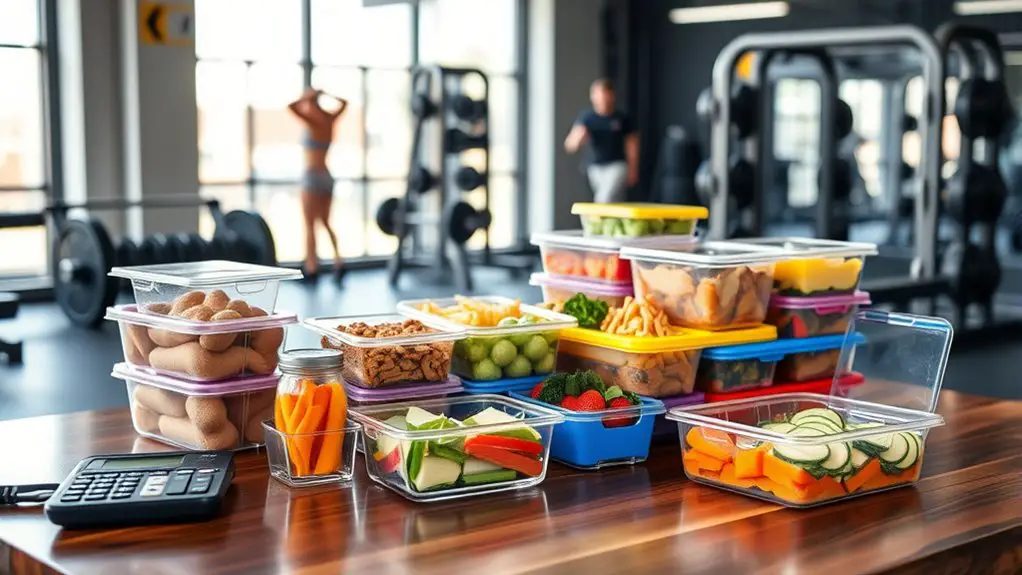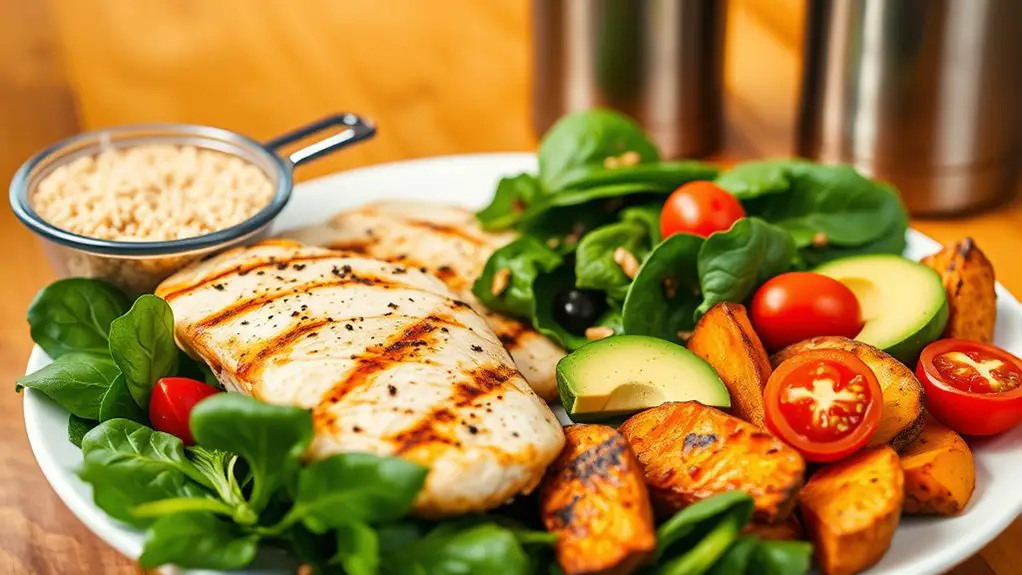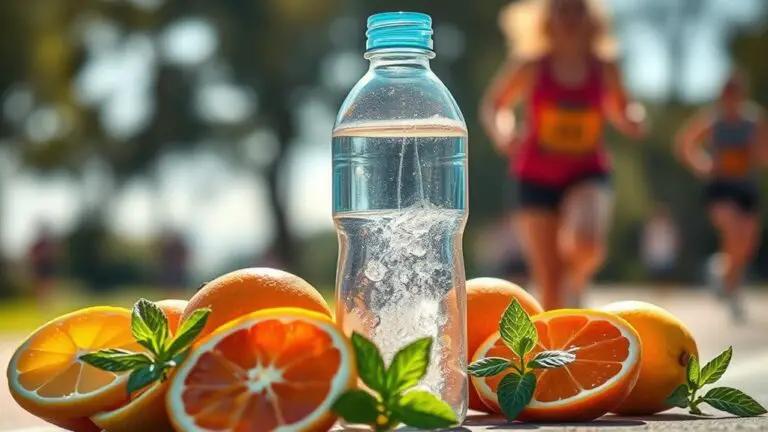The Role of Macronutrients in Fat Loss for Gym-Goers

Macronutrients—carbohydrates, proteins, and fats—play an essential role in your fat loss journey as a gym-goer. Carbs provide energy for workouts, while proteins support muscle repair and growth, helping you maintain lean mass. Healthy fats aid hormone production and keep you satisfied, curbing cravings. Calculating your specific needs and timing your intake can further enhance results. With the right balance, you’ll fuel your workouts and optimize recovery. Discover how to create a meal plan that works for you.
Understanding Macronutrients: An Overview

When it comes to fat loss, understanding macronutrients is essential, as they play a pivotal role in how your body functions and responds to exercise. Macronutrient basics consist of three main components: carbohydrates, proteins, and fats. Each serves distinct purposes, influencing energy levels and recovery.
Carbohydrates are your body’s primary energy source, fueling workouts and daily activities. Proteins support muscle repair and growth, while fats are vital for hormone production and nutrient absorption. Balancing these macronutrients can enhance your fat loss efforts.
It’s important to note that not all foods are created equal; the quality of your macronutrients matters. For instance, whole foods provide better nutrient absorption compared to processed options. By prioritizing high-quality sources, you’ll improve your body’s efficiency in utilizing these nutrients, ultimately supporting your fat loss goals. Understanding and applying macronutrient basics can greatly impact your success on your fitness journey.
The Importance of Protein in Fat Loss
Although many people focus on calorie intake when aiming for fat loss, the role of protein shouldn’t be overlooked. High-quality protein is essential for muscle preservation, especially when you’re in a calorie deficit. Ensuring adequate protein intake can help you maintain lean muscle mass, which is critical for a faster metabolism.
Here are four reasons why protein is necessary for fat loss:
- Satiety: Protein-rich foods keep you feeling full longer, reducing overall calorie consumption.
- Thermic Effect: Your body burns more calories digesting protein compared to fats and carbohydrates.
- Muscle Repair: Protein supports recovery and repair after workouts, preventing muscle loss during fat loss.
- Fat Loss: Higher protein intake can promote fat loss while preserving muscle, leading to a more toned physique.
Incorporating quality protein sources into your diet can greatly enhance your fat loss efforts.
Carbohydrates: Fueling Your Workouts

Carbohydrates play a vital role in fueling your workouts, providing the energy you need to push through intense sessions. Understanding the different types of carbohydrates and when to consume them can greatly enhance your performance and recovery. By timing your carbohydrate intake effectively, you can optimize your energy levels and support your fat loss goals.
Types of Carbohydrates
While you might think all carbohydrates are the same, they actually come in various types, each playing a unique role in your workout and recovery. Understanding these types can help optimize your performance and fat loss. Here are four key categories:
- Simple carbohydrates: Quick energy sources like fruits and honey, beneficial pre-workout for a rapid energy boost.
- Complex carbohydrates: Found in whole grains and legumes, they provide sustained energy and are essential for post-workout recovery.
- Fiber sources: Foods like vegetables and whole grains that aid digestion and promote satiety, helping with fat loss.
- Carbohydrate alternatives: Options like quinoa or sweet potatoes can diversify your diet while keeping glycemic index in check.
Timing Your Carbohydrate Intake
To maximize your workout performance and support fat loss, timing your carbohydrate intake is essential. Focus on pre-workout timing to boost energy levels; consuming carbs 30-60 minutes before exercising can enhance your performance. Consider carb cycling to strategically boost your carb intake on high-intensity days while reducing it on rest days. After your workout, prioritize post-workout nutrition; pairing carbs with protein can improve recovery nutrition and insulin sensitivity, optimizing muscle repair. Additionally, maintaining meal frequency throughout the day guarantees steady energy levels, preventing crashes. By timing your carbs effectively, you’ll not only enhance workout performance but also support your overall fat loss goals.
Healthy Fats and Their Role in Weight Management
When it comes to weight management, incorporating healthy fats into your diet can actually be beneficial rather than detrimental. These fats can support your weight loss goals by promoting satiety, which helps you control cravings and avoid overeating. Here are four key benefits of healthy fats:
Incorporating healthy fats into your diet can boost weight management by enhancing satiety and controlling cravings.
- Enhanced Satiety: Healthy fats help you feel fuller longer, reducing the temptation to snack unnecessarily.
- Nutrient Absorption: They assist in absorbing fat-soluble vitamins (A, D, E, K), essential for overall health.
- Hormonal Balance: Healthy fats support hormone production, including those that regulate appetite and metabolism.
- Improved Metabolism: Including fats like omega-3s can boost your metabolic rate, aiding in fat loss.
Incorporating sources such as avocados, nuts, and olive oil can provide these benefits, making healthy fats a smart choice for anyone aiming for effective weight management.
Calculating Your Macronutrient Needs

To effectively support your fat loss goals, it’s essential to calculate your macronutrient needs. Start by determining your daily caloric intake and then establish the right macronutrient ratios based on your activity level. This practical approach guarantees you fuel your body correctly while aiming for ideal results.
Understanding Macronutrient Ratios
Understanding your macronutrient ratios is essential for effective fat loss, as it directly impacts your energy levels and muscle preservation during workouts. To achieve ideal ratios, you’ll need to focus on your macronutrient distribution. Here’s how to calculate your needs:
- Determine your total daily energy expenditure (TDEE) – This sets your baseline for caloric intake.
- Establish your protein needs – Aim for about 1.2 to 2.2 grams per kilogram of body weight.
- Set your fat intake – Typically, 20-35% of your total calories should come from healthy fats.
- Fill in the rest with carbohydrates – They serve as your primary energy source for workouts.
Daily Caloric Intake Calculation
Calculating your daily caloric intake is a fundamental step in tailoring your macronutrient needs for effective fat loss. To achieve a caloric deficit, you first need to determine your Total Daily Energy Expenditure (TDEE), which includes your basal metabolic rate and activity level. Once you know your TDEE, subtract about 500 calories to create a sustainable caloric deficit, promoting fat loss without sacrificing body composition. Next, divide your remaining calories among proteins, fats, and carbohydrates based on your specific goals. For instance, a higher protein intake can help preserve muscle mass while losing fat. By focusing on your daily caloric intake, you can strategically adjust your macronutrients to enhance your fat loss journey while maintaining ideal body composition.
Adjusting for Activity Level
When you adjust your macronutrient needs, it’s essential to contemplate your activity level, as this directly impacts how many calories and nutrients your body requires. Understanding your energy expenditure helps you make effective activity based adjustments. Here’s how to get started:
- Determine your Basal Metabolic Rate (BMR): This is the number of calories your body needs at rest.
- Factor in your activity level: Multiply your BMR by an activity factor (sedentary, lightly active, moderately active, very active).
- Set your macronutrient ratios: Aim for a balanced distribution of carbs, proteins, and fats based on your goals.
- Monitor and adjust: Regularly assess your progress and tweak your intake as needed to stay on track.
Timing Your Macronutrient Intake for Optimal Results

While it might seem straightforward to focus solely on the quantity of macronutrients you consume, the timing of your intake can greatly influence your fat loss and gym performance. Meal timing plays a vital role in optimizing nutrient absorption, ensuring your body gets what it needs when it needs it. Consuming carbohydrates and protein shortly after your workout can enhance recovery and muscle synthesis, making your gym sessions more effective.
Additionally, spreading your meals throughout the day can help maintain steady energy levels and prevent fluctuations in hunger, which can lead to overeating. Research suggests that eating smaller meals more frequently can improve metabolic rate and nutrient utilization.
Common Misconceptions About Macronutrients
Although many people have a basic understanding of macronutrients, several misconceptions persist that can hinder your fat loss goals. Myth debunking is essential to clear the confusion around these nutrients. Here are four common nutrient misconceptions:
- Carbs Make You Fat: Carbohydrates are crucial for energy; it’s about choosing the right types and amounts.
- All Fats Are Bad: Healthy fats, like those from avocados and nuts, can actually support fat loss and overall health.
- Protein Is Only for Muscle Gain: While it aids muscle repair, protein also helps keep you satiated, reducing overall calorie intake.
- You Need to Avoid All Sugar: Not all sugars are created equal; natural sugars from fruits come with beneficial nutrients and fiber.
Creating a Balanced Meal Plan for Fat Loss

Creating a balanced meal plan for fat loss is essential, as it helps you manage your calorie intake while ensuring you get the necessary nutrients your body needs. To achieve this, focus on macronutrient balance and portion control strategies.
Here are some meal prepping tips to get you started:
| Macronutrient | Recommended Sources |
|---|---|
| Protein | Chicken, tofu, legumes |
| Carbohydrates | Quinoa, sweet potatoes |
| Healthy Fats | Avocado, nuts, olive oil |
| Vegetables | Leafy greens, broccoli |
Incorporate variety in your meals while keeping an eye on portion sizes. Use containers to separate your meals, making it easier to grab and go without overindulging. Remember, consistency is key; stick to your plan, and you’ll see results.
Frequently Asked Questions
Can I Lose Fat Without Tracking Macronutrients?
Absolutely, you can lose fat without tracking macronutrients. By practicing intuitive eating and mindful consumption, you can develop a better relationship with food. Focus on listening to your body’s hunger cues and choosing whole, nutrient-dense foods. This approach encourages moderation and helps you create a sustainable eating pattern. While tracking can be helpful for some, many find success by simply being aware of what they eat and how it makes them feel.
Are There Specific Foods That Help Burn Fat Faster?
There are indeed specific fat burning foods that can help enhance your weight loss journey. Incorporating metabolism boosters like green tea, chili peppers, and lean proteins can increase your body’s energy expenditure. Foods high in fiber, such as fruits and vegetables, also support digestion and keep you full longer. While no single food will magically melt fat away, a balanced diet with these items can accelerate your progress.
How Do Macronutrient Ratios Differ for Men and Women?
When it comes to nutrition, you can’t fit a square peg in a round hole. Macronutrient distribution often varies based on gender differences. Typically, men may require higher protein and fat ratios, while women may benefit from a slightly higher carbohydrate intake for energy. It’s essential to tailor your macronutrient ratios to your individual goals, activity level, and metabolic rate, ensuring you fuel your body effectively for peak performance.
What Are the Best Sources of Plant-Based Protein?
When you’re looking for the best sources of plant-based protein, consider options like lentils, chickpeas, quinoa, and edamame. These foods not only offer protein variety but also come with plant-based benefits, such as fiber and essential vitamins. Incorporating a mix of these sources into your diet can help guarantee you’re getting all the necessary amino acids. Don’t forget to include nuts and seeds, which can complement your protein intake effectively.
Can I Consume Alcohol While Focusing on Fat Loss?
Sure, you can enjoy a drink while trying to lose fat—just like you can drive a car with a flat tire. Alcohol can have significant calorie impacts, often adding empty calories that derail your progress. Its effects on metabolism can also slow down fat burning. While moderation is key, it’s important to be mindful of how those drinks can sneak up on your daily calorie intake and affect your goals.





